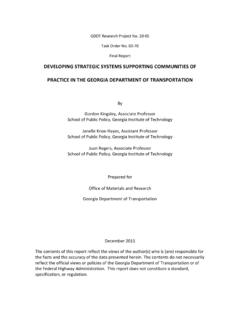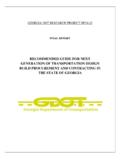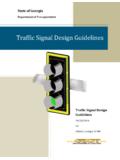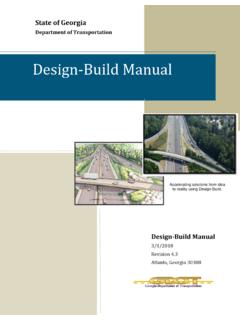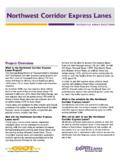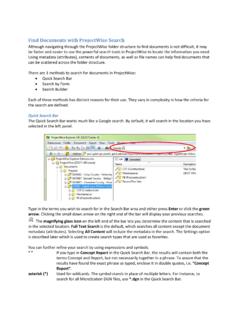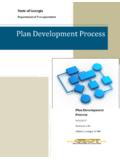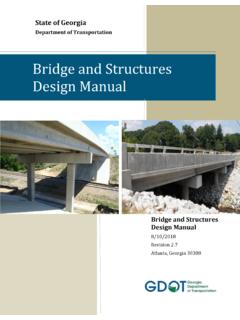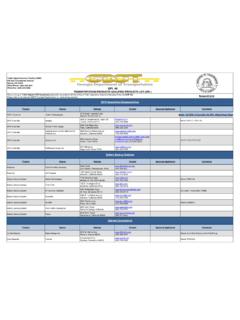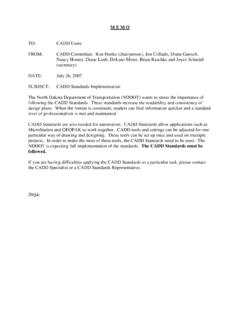Transcription of ProjectWise Fundamentals - Welcome to The GDOT
1 ProjectWise Fundamentals This document is intended to provide an overview of the ProjectWise Explorer application. Please refer to other training documents to further explain other ProjectWise features and procedures in more detail. Opening ProjectWise Double click the ProjectWise Explorer icon on your desktop, or go to Start > All Programs > Bentley > ProjectWise V8i (SELECT series 4) > ProjectWise Explorer. Once ProjectWise Explorer opens, double-click on the ProjectWise Datasource or click the plus (+) sign next to it. If you have an account in the GDOT-AD domain, ProjectWise will use your current login credentials to open. If you are an external consultant wishing to use ProjectWise Explorer, you will double-click on the ProjectWise (via GDOT Gateway) Datasource. You will be prompted for your login credentials for access. Remember: type GADOT\ preceding your username to login. If you log in to a different computer than the one where ProjectWise was installed for your use, you may see a window pop up inquiring about the creation of a working directory.
2 Click Yes if you ever see this window, otherwise ProjectWise will not run. Touring the Interface The ProjectWise Explorer application window is divided into 3 main areas. The left panel lists the datasource, the projects, and the folders within projects similar to how Windows Explorer displays folders. Clicking the plus (+) sign next to any folder will expand it to display the folders contained within it. The upper right panel lists the documents or subfolders stored within the folder selected in the left panel. Icons are displayed next to each document that shows the application it is associated with and the current access you have to the document. There are several columns of information shown in the panel that can be reordered by clicking on the column header. Adding and removing columns is covered in another training document. The lower right panel displays more detailed information about the item selected in the other panels.
3 Project properties that are synchronized from other GDOT databases can be seen here along with folder properties, document properties and previewing panes. The upper right panel allows you to open documents by double-clicking them just like in Windows Explorer. Each document has two icons next to it. The first shows the access level or status of the document. The second icon is the application associated with the document. Document has Read/Write access. The user can open the document and make modifications. Document is Read Only. The document can be opened but not modified. Document is Checked Out to you. It was opened in an application for modifications. It will appear as locked to other users. Document is Locked. It has been checked out and opened by another user. Document has been Exported by you. It will appear locked to other users. Documents can be exported outside of ProjectWise for use in unsupported applications but are still managed by ProjectWise .
4 Documents are Imported back into ProjectWise when the work is completed. Document has been set to Final Status. This document cannot be modified by anyone, regardless of their security access. The Address bar works in a similar way that the top navigation bar does in Windows Explorer. It shows the location path of whatever is selected in the panels. You can use this address as a link to send to others so they can locate the document in ProjectWise . Simply right-click on the address you want as a link and select either Copy URL or Copy URN. Copy URL will set the link to point to the document in that specific location, whereas Copy URN will point to the document itself. Copy URN links will still work if the document gets moved or renamed. Paste this information into an Office document such as Word or an email message. The shortened name will display as the link. Opening Documents in ProjectWise The easiest way to open documents stored in ProjectWise is to double-click on them inside ProjectWise Explorer.
5 The document will open in the associated application for viewing and editing if permissions allow. For fully integrated applications such as Microsoft Office and Bentley applications, you can browse to the document within ProjectWise from inside the application. Working with ProjectWise in MicroStation and InRoads are covered in other training documents. If you have read-only access for the document you are opening, you will see a message verifying that you wish to open the document as read-only. When opening read-only documents, remember that the associated application will allow edits to be made to the document, but these edits will not be allowed back into ProjectWise . You can open a document by right-clicking it as well. The menu that displays offers many more operations that can be performed on the selected document. A few of these operations are described below. Open Performs the same action as double-clicking the document.
6 This action will check out the document to you, create a local copy of it on your computer, mark it as locked to other users, and launch the associated application for viewing and/or editing. Open as Read-Only Will open the document in the associated application for viewing only and the document will remain available for other users to check out and modify. Open - Allows you to choose another supported application to open the document for viewing and/or editing other than the default associated application. Check Out This action will lock the document to other users, make a local copy of it on your computer, but will not open the document in its associated application. This is useful when you wish to lock down the document for editing by others. Check In Allows you to check in a document checked out to you. This will upload any document changes from your local copy to ProjectWise and mark the file available to other users.
7 Free Allows the document to be checked in but ignores any local document changes. This command also purges the document from your local working directory and puts it into your recycle bin. This command is used by Administrators to unlock checked out files that need to be accessed by other users when users have forgotten to check them back in properly. Copy Out Will create a local copy of the document, but will not open it or lock down to other users. This is useful for pre-loading large documents for opening later. This does not copy the document outside of ProjectWise . Export Allows documents to be saved to a location outside of ProjectWise for use in unsupported applications or to send to users with no access to ProjectWise . The command provides two options: Export Locks file, changes can be re-imported. This maintains a managed document in ProjectWise . The document can modified externally and then changes can be uploaded back into ProjectWise using Import.
8 Document is locked in ProjectWise until imported or freed. Send to Folder Creates unmanaged local copy. This will create a copy of the document in a location you determine outside of ProjectWise which cannot be imported back in. Documents do not become locked when exported in this manner. Closing Documents in ProjectWise After completing work on a document in a supported application, ProjectWise will provide options for checking the document back into the server. The General Tab opens by default. It lists the documents ready to be checked in along with the following options: Check In - This will upload any document changes from your local copy to ProjectWise and mark the file available to other users. Update Server Copy This option updates any changes to ProjectWise but keeps the file checked out. Free This option allows the document to be checked in but ignores any local document changes.
9 This command also purges the document from your local working directory and puts it into your recycle bin. This option may also be used if you have done work in a document and do not wish to save the work you have done back into ProjectWise . Cancel Dismisses the Check In window with no changes. The document remains checked out to you. The Comment tab can be used to log any pertinent information about the document s changes. These comments are visible in the Audit Trail for anyone with proper access to the document.
